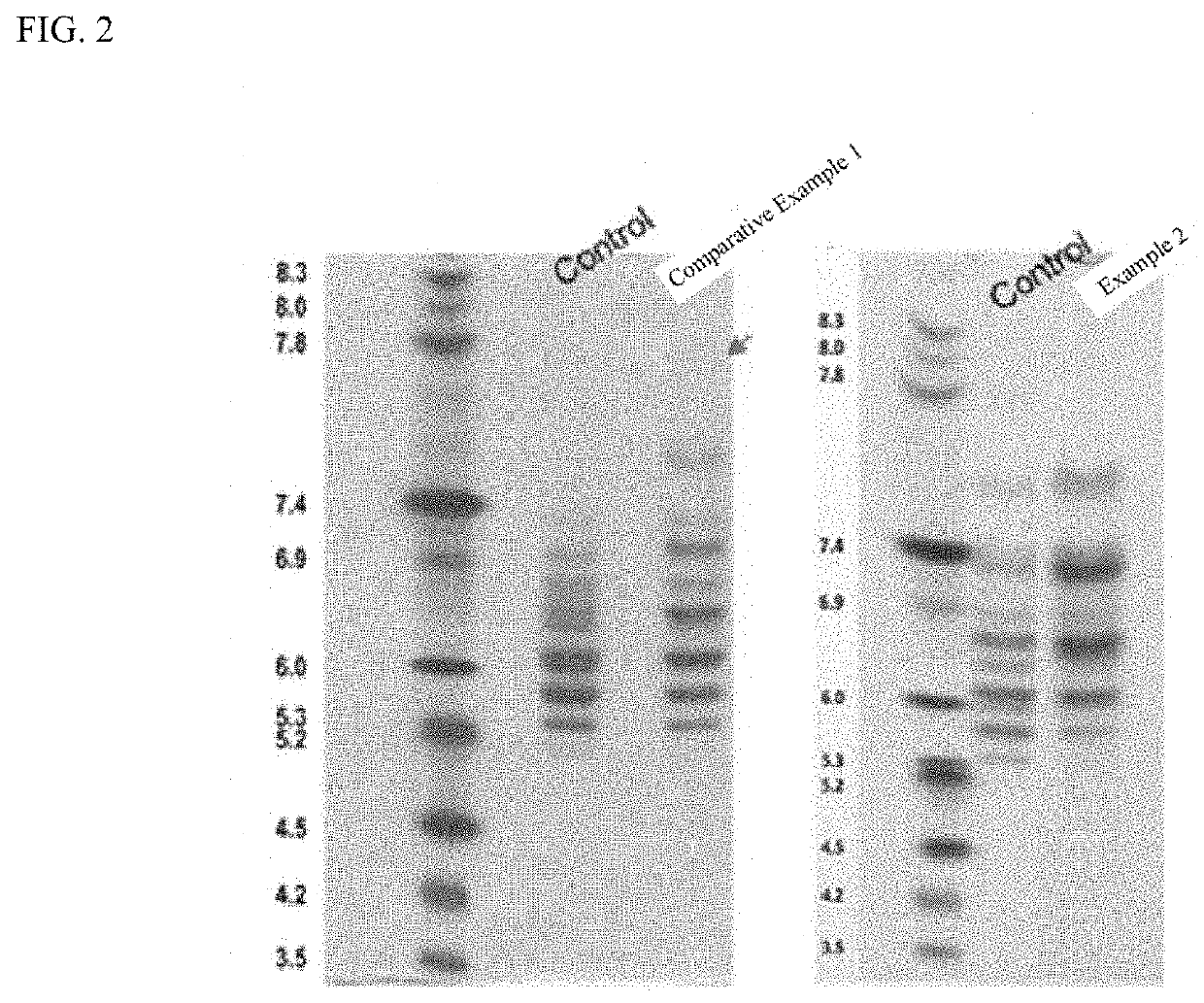Method for purifying diglycosylated interferon-beta protein
a diglycosylated interferonbeta and protein technology, applied in the field of purifying a diglycosylated interferonbeta protein, can solve the problems of special equipment, insufficient purification effect, damage to purified proteins, etc., and achieves excellent purification yield, easy manufacturing management, and excellent quality.
- Summary
- Abstract
- Description
- Claims
- Application Information
AI Technical Summary
Benefits of technology
Problems solved by technology
Method used
Image
Examples
example 1
Expression and Obtainment of Diglycosylated Interferon-Beta in Host Cells
[0088]A culture solution expressed interferon-beta by culturing a producing CHO cell line including a corresponding diglycosylated interferon-beta gene in a 5 L scale using a medium based on optiCHO SFM of Hyclone.
[0089]The culture solution was cultured while slowly stirring at an initial temperature of 34.0° C., pH 7.0, and 50% dissolved oxygen, and cultured for 9 days, and then the culture solution recovered from an incubator was centrifuged under conditions of 4500 rpm and 4° C. for 30 minutes. After the centrifugation, a supernatant was aseptically subjected to 0.22 μm filtration, and purification was performed.
example 2
Purification of Diglycosylated Interferon-Beta
[0090]The interferon-beta obtained in Example 1 was added to a purification process using affinity chromatography.
[0091]First, the harvested interferon-beta fractions were bound with a Blue sepharose 6 fast flow (GE) column pre-equilibrated with a solution of 10 mM sodium phosphate, 137 mM NaCl, 2.7 mM KCl, and pH 7.4, and sufficiently washed with a 700 mM sodium thiocyanate solution. Thereafter, the interferon-beta fractions were eluted with a solution of 20 mM sodium phosphate, 1.4 M NaCl, 35% propylene glycol, 250 mM L-Arginine, and pH 7.4 to be harvested.
[0092]As a result of HPLC analysis, purity of 94% to 96% was shown, and as a result of residual HCP detection, the first purification was completed with the content of 6300 to 9500 ppm.
[0093]In a second step, pH 3.5 of phosphoric acid (99%, and 10-fold diluted using distilled water) was added to adjust the pH to 3.0. Thereafter, the phosphoric acid was treated at 22° C. for 1 hour an...
example 3
Evaluation of Purification Method
[0103]3-1. Evaluation of Activity, Yield, etc.
[0104]The purification methods of Example 2 and Comparative Example 1 were evaluated in terms of yield, modification of the protein, inactivity, content, and total activity.
[0105]The protein quantification used a UV measurement method. A zero point was adjusted by a solution of adding 0.5 M NaOH and a size exclusion chromatography eluting solvent at 1:1 and a product obtained in the size exclusion chromatography and 0.5 M NaOH were mixed at 1:1 and measured at UV wavelength 290 nm. The measurement was based on three times and was digitized by the following Equation.
(Average of 3 measured values÷extinction coefficient)×dilute magnification (mg / mL)
[0106]The yield was based on an elute (100%) passing through blue sepharose and a relative content thereto was measured by an enzyme-linked immunosorbent assay (ELISA) using a primary antibody specific to interferon-beta, and the ELISA used at this time was as fol...
PUM
| Property | Measurement | Unit |
|---|---|---|
| temperature | aaaaa | aaaaa |
| pH | aaaaa | aaaaa |
| temperature | aaaaa | aaaaa |
Abstract
Description
Claims
Application Information
 Login to View More
Login to View More - R&D
- Intellectual Property
- Life Sciences
- Materials
- Tech Scout
- Unparalleled Data Quality
- Higher Quality Content
- 60% Fewer Hallucinations
Browse by: Latest US Patents, China's latest patents, Technical Efficacy Thesaurus, Application Domain, Technology Topic, Popular Technical Reports.
© 2025 PatSnap. All rights reserved.Legal|Privacy policy|Modern Slavery Act Transparency Statement|Sitemap|About US| Contact US: help@patsnap.com


